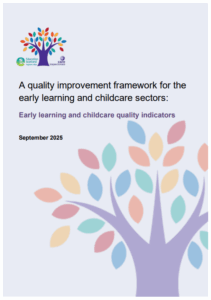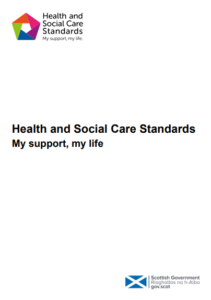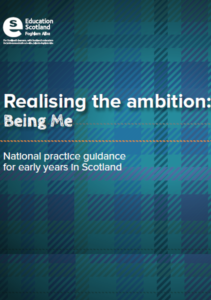Getting It Right For Every Child (GIRFEC)
– Reflecting on Practice
Staff Skills, Knowledge, Values and Deployment p10 – Staff skills, Knowledge and Values
We have a clear understanding of how children learn and develop, having high aspirations for children’s achievements. We make very good use of professional development opportunities that link directly to enhanced outcomes for children, their individual learning needs and our improvement plan. Research, best practice, national and local policy, underpinning legislation, the United Nations Convention on the Rights of the Child (UNCRC) and the Health and Social Care Standards are used in this process.
Leadership of Continuous Improvement p11 – Pedagogical Leadership
There is a strong focus on improving wellbeing and educational outcomes for children. Staff demonstrate a determination to recognise, respect and promote children’s rights. This reduces inequity, challenges discrimination and improves outcomes for all. We actively use local and national guidance and evidence-based research about how children learn. This informs our pedagogy and all aspects of our practice.
Children experience high-quality spaces p20 – Quality, safety and maintenance of spaces
Our physical environment, whether offered indoors or outdoors, is welcoming, fully meets children’s needs, and is well equipped. It gives a strong message to children that they matter. We make the best use of available resources to create, sustain and enhance a motivating physical environment. As a result, children experience high-quality care and learning centred on their needs and interests.
Children experience high-quality spaces p22 – Children influence and affect change
We have an inclusive environment where children have a belief in their abilities. Carefully selected and well-positioned furniture and resources support all children to make choices and freely play. Resources and materials available to children are varied, adaptive and responsive, catering to children’s individual abilities, needs and interests. We understand the positive impact that rich, multi-sensory play has on children’s learning, resilience and wellbeing.
We have a supportive environment where children are valued and celebrated. High-quality resources and spaces promote diversity, equity and inclusion. Children, their families and wider communities are positively reflected in the resources, spaces and experiences available. Children feel seen and included. Our enriching setting fully supports children to develop their knowledge, respect and understanding of their community and wider world.
p25
How inclusive is our setting for all children and families? Does it accommodate and promote emotional safety?
Nurturing Care and Support p47 – Personal Planning
Our approach to personal planning considers best practice guidelines and is grounded in the Getting it Right for Every Child (GIRFEC) framework, utilising wellbeing indicators to assess and plan for children’s overall wellbeing. The indicators provide us with a common language for assessing and discussing children’s strengths, needs and progress with families and other professionals.
Children’s wellbeing is supported through effective personal planning. All children, regardless of their personal characteristics, are recognised as capable individuals who are listened to, valued and respected. Personal plans promote children’s rights and value the individuality of each child and their family. Personal plans are tailored to each child’s individual strengths, needs and interests. We create meaningful plans with children and regularly review these to ensure plans are suitable and supportive.
Nurturing care and support p49 – Connections with families
We know our children and families very well. We strive to create a warm and welcoming environment where children and families feel valued and supported. The care we provide children is deeply influenced by insights gained from their family. This supports us to create spaces which are culturally sensitive, accessible and inclusive for all.
Our connections with families increase their engagement in our service, positively impacting the quality of children’s experiences. We recognise, learn from, and build upon the strengths that families bring, while sensitively responding to individual needs and circumstances. This collaborative approach enables us to learn from families, support children’s growing sense of self, and ensure our setting remains responsive to their unique needs.
p51
When children and their families arrive at our setting, how do we know they feel welcomed?
Wellbeing, inclusion and equality p53 – Positive relationships and wellbeing
Relationships are based on respect, honesty and trust and getting it right to improve outcomes for children and families. We actively support our children to be safe, healthy, achieving, nurtured, active, respected, responsible and included. We can demonstrate the significant impact this has on our children’s social, emotional, and mental wellbeing as well as their development and learning.
Each child is valued by staff as an individual with their own personality, views, needs, and rights. We actively encourage children’s participation in a developmentally appropriate way. This enables children to communicate their views, in their own way, about their wellbeing and engage in decisions which affect them.
Wellbeing, inclusion and equality p55 – Identifying and assessing learning needs and targeted support
We make very effective use of the national wellbeing indicators to provide holistic assessment of children’s strengths and support needs. We ensure that children with additional support needs are identified early and supported through well-planned, regularly reviewed interventions.
p57
To what extent do we have regular, high-quality professional learning to support wellbeing, inclusion and equality? What impact does this professional learning have
Safeguarding and Child Protection p65 – Legislation, Policy and Guidance in Practice
Our robust approach to self-evaluation fully informs our arrangements for recognising, responding to, recording and reporting concerns about children’s wellbeing or safety. We use legislation, national guidance and policies to support our self-evaluation. We proactively take account of new information, policy developments and emerging issues to improve our practice.
Safeguarding and Child-protection p67 – Empowering children and staff
Our interactions are underpinned by children’s rights. We know individual children very well. We communicate respectfully with families and one another to develop a holistic knowledge of children and their wellbeing needs.
p69
To what extent does regular, high-quality, professional learning improve our practice?
What changes have we made as a result of professional learning? How do we know practice changes have had a positive impact for children and/or staff?
1.27 I am supported to achieve my potential in education and employment if this is right for me. 2.27. As a child, I can direct my own play and activities in the way that I choose, and freely access a wide range of experiences and resources suitable to my age and stage, which stimulate my natural curiosity, learning and creativity.
3.13 I am treated as an individual by people who respect my needs, choices and wishes, and anyone making a decision about my future care and support knows me.
3.20 I am protected from harm, neglect, abuse, bullying and exploitation by people who have a clear understanding of their responsibilities.
3.21 I am protected from harm because people are alert and respond to signs of significant deterioration in my health and wellbeing, that I may be unhappy or may be at risk of harm.
3.22 I am listened to and taken seriously if I have a concern about the protection and safety of myself or others, with appropriate assessments and referrals made.
4.17 If I am supported and cared for by a team or more than one organisation, this is well coordinated so that I experience consistency and continuity.
p37
The GIRFEC approach is designed to be flexible enough to support all children and families whatever their need, whenever they need it. It is about responding in a meaningful, supportive way, working with parents and carers wherever possible.
p38
Best practice will;
- put the best interests of the child at the heart of decision making,
- take a holistic approach to the wellbeing of a child,
- work with children, young people and their families on ways to improve wellbeing,
- advocate preventative work and early intervention to support children, young people and their families, and,
- believe professionals must work together in the best interests of the child.



